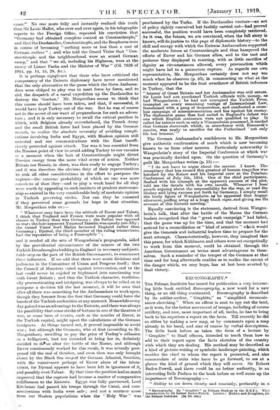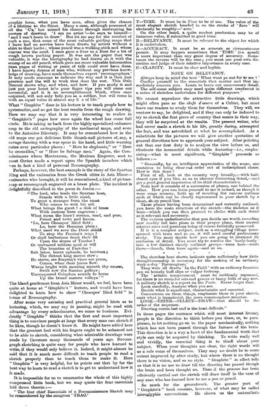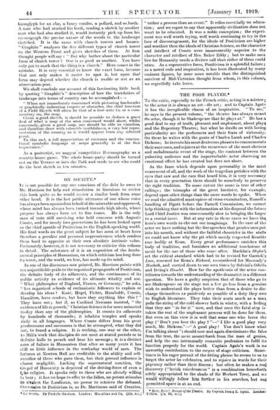RECONOGRAPELY.*
Tick Pelman Institute has issued for publication a very interest- ing little book entitled Reconography, a new word for a new thing, or an old thing reanimated. Reeonography is described by its soldier-author, "Graphite," as "simplified reconnais- sance sketching." When an officer is sent to spy out the land, as it were, for the better movement of troops, including of course artillery, and now, most important of all, tanks, he has to bring back to his superiors a report on the facts. Till recently he did so either by making a new map, or by comments upon a map already in his hand, and also of course by verbal descriptions The little book before us takes the form of a lecture by " Graphite " to Staff officers, intended to trash them how to add to their report upon the facts sketches of the country with which they are dealing. His method may be described as a kind of picture-writing or symbolic landscape-painting, which enables the chief to whom the report is presented, and also commanders of units who have to go forward, to see at a glance the kind of ground which they will cover. Sir Robert Baden-Powell, and there could be no better authority, in an interesting little Preface to the book before us well sums up the importance of Reconography :—
"Ability to act down clearly and concisely, preferably in a
• Rseenegrephy. By " Graphite (a relines stalest In the B,11.X.). With Introduction by Sir Robert Dedes-Powell. Loudon Hodder end &ought**, for the Pekoes nudist*. Els. M. se4.1 graphic form, what you have seen, often gives the chance of a lifetime to the Scout. Many a man, although possessed of all the • C's,' has missed his chance through mistrusting his powers of drawing. 'I am no artist '—he says to himself- ' and I can't learn to draw.' But let me say for the comfort of such a one, that some of the most valuable guiding maps that I have had on service have been drawn by artiste without a shirt to their backs ; whose pencil was a walking-stick and whose canvas was the sand. I once gave a fiver to a Boer for a hit of rough brown packing caper. It was not the paper that was valuable, it was the Inerography he had drawn on it with the stump of an old pencil, which gave me more valuable information than pages of writing or years of talk could over have done. I have known dozens of men who, without may previous know. ledge of drawing, have made themselves expert reconographers.' It only needs someone to indicate the way and it is then just practice and the will to work that does the rest. This little Manual shows why, and what, and how. If you study it and just put your heart into your finser tips you will come out successful, and it is an accomplishment whioh, when once acquired, will not only help you as a soldier, but will corns In with en equal value in almost any Ii e of life."
What " Graphite " does in his lecture is to teach people how to systematize, and so get the best results from the rough drawing.
Here we may say that it is very interesting to realire in " Graphite's " pages how once again the wheel has come full circle. He is taking us book from the highly specialized ordnance map to the old cartography of the mediaeval maps, and even to the Antonine Itinerary. It may be remembered how in the old maps one got delicious little thumb-nail pictures of, say, a
savage dancing with a war spear in his hand, and little warning
notes over particular places "Hers be elephants," or "Hare be crocodiles," or "Here be Salvage men." Again, the Com- missioners whom Montezuma, the Mexican Emperor, sent to meet Cortez made a report upon the Spanish invaders which was in fact a kind of personal Reconography.
Perhaps, however, the best example is the story of the Spartan
King and the emissaries from the Greek cities in Asia Minor—
emissaries who brought, it will be remembered, a kind of picture.
mapor reconograph engraved on a braes plate. The incident is delightfully described in the poem in /cam
"The lord, who leads the Spartan host,
Stands with n little maid, To greet a stranger from the coast Who comae to-seek his aid.
What brings the guest ? a disk of brass With Curious lines engraven What mean the lines? stream, road, and pass, Forest and town and haven.
'Le, here Choaspee' lilied Said Lo, here the Herman plain What need we save the Doric shield To atop the Persian's reign ?
Or ;than barbarians drink their fill
Upon the slopes of Tmolus ? Or trowsered robbers spoil at will The bounties of Pactolus ?
Salt lakes, burnt uplands, lie between ; The distant king moves, slow ; He starts, ere Smyma's vines are green, Comes, when their juices flow.
Waves bright with morning smooth thy course, Swift row the Samian galleys ; Unconquered Colophon sounds to horse Up the broad eastern valleys.' "
The bland gentleman from Asia Minor would, we feel, have been quite at home at " Graphite's " lecture, and would have been delighted to learn how to show " Choaspes' lilied field" in terme of Reeonography.
After some very amusing and practical general hints as to lecturing, which, we may say in passing, might be read with advantage by every schoolmaster, we come to business. Evi- dently " Graphite " thinks that the first and most important thing is to convince people at large that every man can sketch if he likes, though he doesn't know it. He might have added here that the greatest fool with his fingers ought to be ashamed not to be able to sketch, considering what admirable drawings were made by Cavemen many thousands of years ago. Recono- graph sketching is quite easy for people who have learned to write, if they would only believe it. Indeed, it might almost be said that it is much more difficult to teach people to read a sketch properly than to teach them to make it. Here " Graphite " is very helpful, for he points out that by far the best way to learn to read a sketch is to get to understand how it is made.
It is impossible for us to summarize the whole of this highly compressed little book, but we may quote the four essentials laid down therein :— " The four chief Essentials of a Reconnaissance Sketch may be remembered by the anagram TRAO.' T—TIME. It most be in Time to be of use. The value of the most elegant sketch handed in on the stroke of ' Zero ' will obviously be roughly—'
On the other hand, a quite modest production may be of immense value, if submitted in good time.
R—RELEVANOY. It must be referred to the object for which it is undertaken.
A—ACCURACY. It must be as accurate as circumstances permit. It may happen sometimes that ' TIME ' (i.e. speed> Is more Important than any great degree of accuracy. Some- times the reverse will be the ease you must use your own die. oretion and judge of their relative importance in every ease. C—CLARITY. It must be clear and legible.
NOTE ON RELEVANCY.
Always keep in mind the text ' What went ye out for to see?' Confine yourself to the essentials that matter and that im- mediately concern you. Learn to leave out unnecessary detail. The self-same subject may need quite different treatment in a series of sketches undertaken for different purposes."
We cannot reproduce the attractive little drawings, which might often pass as the chefs c V alum of a Cubist, but must leave our readers to study them for themselves. They will, we venture to say, be delighted, and if they can only be Induced to try to sketch the first piece of country that ()ernes in their way, they will be surprised at the results. The present writer, who had never made a sketch in his life, greatly daring, attempted the feat, and was astonished at what he accomplished. As a substitute for the pictures we will give another quotation of general directions how to approach your subject. After pointing out that our first duty is to analyse the view before us, and eliminate the inemential details while featuring—i.e., empha- sizing—what is most significant, " Graphite " proceeds as follows :— " Generally, by an intelligent appreciation of the scene, one contrives to bring clearcut order out of ludiseiplined chaos. How is this done ?
First of all, look at the country very broadly,—with half. closed eyes if you like, so as to obscure distracting detail,—and gets good general impression of its ohlef characteristics. Note how it consists of a succession of planes, one behind the other. How you can foroe yourself to see it indeed, as though; it were stage scenery, built up of receding flat canvas outlines each of which can be clearly represented in your sketch by a clean, sh irp pencil line. These planes having bean determined and correctly outlined, you have the main structure of the sketch—the skeleton as it were—which you can then proceed to clothe with such detail as is relevant and necessary. The various underieatures that you decide are worth recording now readily fall into place in their proper plane, their correct relative sizes and positions being of course faithfully preserved.
If it is a complex eubjeot, such as a straggling village inter- spersed with trees and so on, it will need careful preliminary study. You must decide how you are going to interpret its confusion of detail. You must try to resolve the ' hurly-burly ' into a few distinot clearly outlined groups—trees here—roofs there--church, then trees again—and so on.
• •
The sketches here shown indicate quite sufficiently how little draughtsmanahip is necessary for the making of an ordinary work-a•day Reconograly
They were all drawn In the Field' with an ordinary fountain pen on homely buff slips or vulgar foolscap.
The 'artistic temperament ' must be ruthlessly repressed, for there is no room for airs and graces or fancy frills of any sort. A military sketch is a report on the Facia. Never forget that. Look carefully, Analyse what you see. Decide what is significant, characteristic and essential. Concentrate on these things, emphasize them in .your sketch, omit what is immaterial, the mere commonplace minutiat. LOOK—THINK—SELECT—DRAW—that should he the order of the sequence. Drawing comes last and is the least difficult."
In these pages the sentence which will meet interest literary people is the direction to think before you draw, or, to para. phrase, to let nothing go on to the paper mechanically, nothing which has not been pulsed through the fumaoe of the brain This direction is in a way a facet of the fundamental truth that style can only be acquired by thinking. To write really well and vividly, the essential thing n3 to think about your subject. When your thoughts are clear, the right words will as a rule come of themselves. They may no doubt be to some extent improved by after study, but where there is no thought there is no vision, and so no style. " Graphite " in effect tells us that it is no use to draw till the drawing has passed though the brain and been thought on. Then if the process has been efficiently carried out the sketch will draw itself in the case of any man who has learned how to use a pen or pencil.
So much for the groundwork. The greater part of " Graphite's " book consists, however, of what may be called
hieroglyphic conventions. He shows us the naturalistic hieroglyph for an eh, a fancy conifer, a pollard, and so, forth. A man who had studied his book, reading a sketch by another man who had also studied it, would instantly pick up from his monograph the precise nature of the woods in the landscape sketehed. It is the same with church towers and houses- " Graphite " analyses the five different types of church tower on the Western Front and gives sketches of them. At first thought people will say : " But why bother about the particular form of church tower ? One is as good as another. You have only got to mark that the thing is a church." Here comes in the mistake. It is very essential to know the exact form, because that not only makes it easier to spot it, but upon that form may depend whether the church is usable or not as an observation-post.
We shall conclude our account of this fascinating little book by quoting " Graphite's " description of how the translation of landscape into terms of country can be accomplished :—
" When not immediately concerned with picturing landmarks or graphically indicating targets or obstacles, the chief function of a Field Sketch will often be that of a fool mote to, or a com- mentary on, the map.
Given a good sketch. it should be possible to deduce a great deal of what a map of the area concerned would show, whilst conversely, given a good map, one should be able to visualize, mid therefore draw with tolerable truthfulness. a very fair repre- sentation of the country as it would appear from any selected pomh To this end, a full appreciation of contours and the COnven- timid symbolic language of maps generally is of the that mor lance."
As a postscript, we suggest-competitive Reconography as a country-house game. The whole house.party should be turned out on the Terrace or into the Park and made to see who could do the best sketch in ten minutes.




































 Previous page
Previous page